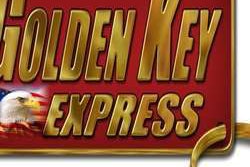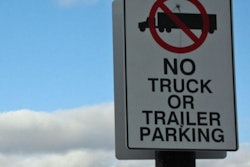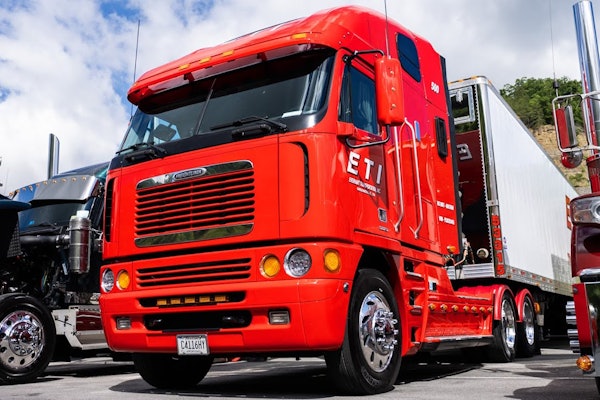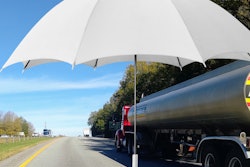Doug Woolverton of Hunter Engineering uses an electrically driven rubber roller to accelerate this Peterbilt front axle wheel to highway speed, at which imbalance can easily be measured. Then the roller is pulled away so that it won’t interfere with what the wheel is doing.
Take an imbalanced 22.5-inch tire, put it in motion, and you’ve got a powerful force. “At 60 mph, a 6-ounce dynamic imbalance becomes 60 pounds of side force per revolution,” says Nick Powers, director of heavy-duty sales at Hennessy Industries, maker of Coats truck alignment and balancing equipment.
Each blow chips away at tire life, fuel economy and steering and suspension components.
That’s why it pays bigger than expected dividends to make sure your tire balance program is routine and thorough.
Imbalance gives shocks an especially hard time, says Doug Woolverton, a division manager at Hunter Engineering, a manufacturer of wheel alignment and tire balancing equipment for cars and trucks. “Shock absorbers are designed to dampen movement in the suspension from occasional bumps, not a constant vibration,” he says. Imbalance creates heat that shock fluids and seals are not designed for. It also puts tremendous stress on spring shackles, kingpins and the tiny ball bearings in tie rods and other steering components.

“Imbalance is there, even when the driver does not feel it,” Woolverton says. “When the driver doesn’t notice it at some speeds, it’s only because it’s not transmitted into the cab under those conditions.”
When you consider the costs of suspension and steering repairs commonly caused by imbalance, it’s easy to justify the cost of wheel balancing.
A set of shock absorbers for a three-axle tractor would cost you about $500, says Bill Valenti, a service adviser at the TravelCenters of America in Paulsboro, N.J. The labor alone for a set of kingpins would typically be about $200 and, for a pitman arm, $350. Including the cost of parts, a couple of front-end repairs like these could easily set you back $750 or more.
Consider the cost of dynamically balancing the 10 wheels of a three-axle tractor – about $250. If doing so just twice were to delay installation of shock absorbers from two years to four years, you save the cost of balancing on shocks alone. Delaying those $750 front-end repairs from three years to six would pay for balancing three times.
Woolverton points out that deteriorating front-end components affect alignment and, ultimately, both tire wear and fuel economy. Consider a trucker who runs 100,000 miles a year, gets 6 mpg, and buys fuel at $2. If expenditures of $1,650 on alignment and balancing (two alignments at $200 and five balancing operations at $250) net him a fuel savings of just 1 percent over a period of 5 years, he comes out slightly ahead on costs, saving $1,666 on fuel alone. The savings in tire, suspension and steering parts wear are gravy.
There are two different balancing processes: static and dynamic. Static balance gets rid of only up and down motion, but dynamic balancing also gets rid of wobble. This is because the static process balances the overall mass around the center of the wheel, while the dynamic process balances both sides of the wheel independently.
Static balancing can be done with the wheel on the vehicle. It typically involves installing a weight only on one side. Dynamic balancing, on the other hand, recognizes that the weight of tire and wheel won’t actually be even from side to side, Powers says. The assembly is removed from the truck and spun on a device that is sensitive to both these kinds of motion, and then weights of different sizes are installed on either side. This eliminates any wobble in the wheel that could be annoying to the driver or destructive to the vehicle, especially on the front axle.
Which of these processes should you use? Powers and Guy Walenga of Bridgestone/Firestone recommend dynamic balancing because it addresses two problems, not just one. “There is both wheel hop and a lateral moment,” Walenga says.
Woolverton’s company, Hunter Engineering, does static balancing, but in a sophisticated way. Since Hunter’s system balances the wheel, hub and drum as an assembly mounted on the truck, any variables in the brake drum or hub that could contribute to a problem will be balanced out, Woolverton says.
Powers counters that drum and hub manufacturers rely less and less on tiny weights that occasionally fall off, so unbalanced drums and hubs are rarely a problem nowadays.
In short, you can benefit from either static or dynamic balancing, but dynamic is more precise. If you experience annoying vibration in the cab or steering wheel, or have vibration-related maintenance problems, you may want to insist on dynamic balancing, especially if static balancing doesn’t quite resolve a problem.
BALANCING BASICS
WHAT DOES IT COST? Basic static balancing, in which the wheel is spun by a motor to increase accuracy, costs $15 to $20 per dual wheel with the tire off the truck, or $30 to $40 for the two tires on a front axle, estimates Doug Woolverton of Hunter Engineering. Nick Powers of Hennessy Industries estimates the cost of a dynamic balance at $18 to $26 per wheel.
HOW OFTEN? Balancing should be done once or twice a year, whenever replacing or retreading tires, and whenever vibration symptoms occur. It’s foolish to wait until you see irregular wear because at that point the tire is already ruined, Powers says.
WHICH AXLES? Steer tires are most susceptible to irregular wear, so they get first priority, says Guy Walenga of Bridgestone/Firestone. Drive axles have a much higher mass that dampens vibration, and imbalance in dual tires tends to average out a bit, Woolverton says.
The drive axle could be the next priority, though, if the ride isn’t smooth, Walenga says. A feeling that the seat is pitching forward and backward may indicate drive tire imbalance, but uneven mounting is another likely culprit. The easiest diagnostic on a drive tire is just to eyeball the distance between the guide ring and the rim all around, Walenga says. Variation means the tire should be broken down, the beads and wheel thoroughly cleaned and lubed and the tire remounted.
WHAT ABOUT TRAILER TIRES? Most trucking companies, Powers says, balance only tractor tires. But that thumping noise audible from passing trailers most often arises from extreme imbalance, especially when unloaded, he says. The result can be cupping wear, indicating a need for balancing. While trailer axles are lighter than drive axles, trailer tires still “are not as sensitive to imbalance as the steers,” Woolverton says.
Walenga advises balancing trailer tires only in case of irregular wear and rough ride, and then only if you’re sure the shocks are not the problem. “Trailer tires have shallow tread, are light in weight and in general are more uniform,” he says.
A dead giveaway that vibration is caused by imbalance, Woolverton says, is that it shows up only at certain speeds.
BALANCING AT 65 MPH
While they don’t eliminate the need for more thorough and precise balancing in the shop for problem tires and wheels, some products do help tires maintain balance while they’re generating miles – and income. For a relatively modest investment, they can save a lot of money by gaining thousands of extra miles from your tires.
Earl Evans of Canfield, Ohio, runs a new Kenworth and hauls less-than-truckload and expedited loads on his flatbed. He swears by the Centramatic balancers he uses on all three tractor axles.
Thanks to the Centramatics and the improved alignment on new trucks, Evans has seen steer tires last 200,000 miles. “I’ve never been able to do that before,” he says. He gets 435,000 miles on his drive tires, another record, he says.
Centramatics slide over the studs before the wheel goes on. They incorporate ball bearings in a lube oil running inside a circular tube.
Balance Masters work similarly, but use mercury in the tube. Gordon Bow of Oakfield, N.Y., who also runs a Kenworth, was frustrated with the up-and-down hop at the rear of his 53-foot low-belly flatbed when he discovered Balance Masters at a Flying J in Wisconsin. He says the product “took out 95 percent of the hop.”
Bow says he now gets 250,000 miles a year on his trailer tires, 80,000 more than before. His steers last 100,000 miles without irregular wear.
The Centramatic catalog pegs their cost at $189 to $199 per axle, depending on wheel style. These devices should each replace several balancing cycles at up to $26 per wheel per balancing operation.
Other motion-activated products are designed to be inserted into the tire. These balancing compounds, such as Equal and Counteract Balancing Beads, adjust continuously to changes in wheel dynamics and normally need to be replaced only when the tire is de-mounted, making them quite cost-effective. Equal, for example, can be installed for about $15 per wheel.
RESOURCES
Hennessy Industries
www.hennessy-ind.com
(800) 688-6496
Hunter Engineering
www.hunter.com
(314) 731-3020
Balance Masters
www.balancemasters.com
(800) 786-8324
Centramatic
www.centramatic.com
(800) 525-8473











